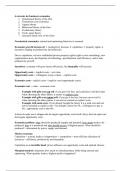6 currents in (business) economics
1. Neoclassical theory of the firm
2. Transaction cost economics
3. Agency theory
4. Behavioral theory of the firm
5. Evolutionary theory
6. Tools: game theory
7. (resource based view of the firm)
Neoclassical economics: rational and optimizing behavior is assumed
Economic growth because of: 1. productivity increase, 2. capitalism, 3. property rights, 4.
incentives leading to productivity and efficiency
Due to capitalism, we have established private property rights (right to own something), new
organizations arose, development of technology, specialization, and efficiency, and in turn
productivity growth.
Incentives: economy will grow (more efficiency), but inequality will increase.
Opportunity costs = implicit costs = net value
Opportunity costs = willingness to pay (value) – explicit costs
Economic costs = explicit costs + implicit costs (opportunity costs)
Economic rent = value – economic costs
- Example with gifts you can sell: if you got it for free, and could have sold the ticket
when choosing the other option, it counts as explicit costs
- Example with gifts you cannot sell: if you got it for free, but you can not sell it
when choosing the other option, it can not be counted as explicit vosts.
- Example with sunk costs: if you already bought the ticket, it is a sunk cost and can
not be included as explicit costs. You bought a ticket for 50,-, willingness to pay is
60,-, opportunity cost is also 60,-.
Je kiest de optie om te skippen die de laagste opportunity costs heeft, dus je kiest de optie met
de hoogste opportunity costs.
Economic problem: what should be produced (supply and demand), how much needs to be
produced, how it is produced and who should receive it (highest payer). What should be
produced > determined by prices, supply and demand.
Market economy:
Capitalism > scarcity leads to compromises > competition > most efficient allocation of
resources > efficiency, productivity and inequality.
Capitalism as an invisible hand: prices influence our opportunity costs and optimal choices.
Marginal analysis: determine how much we should produce while being rational and
optimizing. What quantity leads to highest profit or happiness?
, Most efficient point: where marginal benefits are equal to marginal costs: point
closest to where MB are higher than MC.
Size of economy: measured in GDP > sum of all income of all citizens OR sum of all value
added. Total value of economy is all consumption + investment + spending + Ex-Imports.
GDP per capita corrected for inflation & GDP per capita corrected for PPP (koopkracht).
Economic growth means increase in GDP per capita.
Production possibility frontier: all combinations for producing two goods. Trade &
exchange cause PPF to shift outward, because more can be produced in the same time due to
specialization > called: welfare-enhancing effect.
More trade > more specialization > higher productivity > lower opportunity costs >
higher wealth/GDP. For trade: come to consensus regarding price, which should lie:
between opportunity costs of both producers.
Absolute advantage: measured in e.g. hours of labor / amount of a product > when someone
has absolute advantage in both products, seem that it is not effective to trade.
Comparative advantage: effective to trade/specialize because of lower opportunity costs.
Someone can have comparative while not having absolute advantage. One can produce a,
because they have to give less B up.
Free trade also has negative sides: both gains and losses. Positive & negative externalities
> when left to the market: inefficient outcome (too much consumption with negative
externalities and too little consumption with positive externalities)
Neoclassical economics: perfect markets
- Perfect competition
- Homogeneous goods
- Free entry & exit
- Large amount of buyers and sellers
- No market power (no price influence)
- Free, perfect and symmetric information
- Market functions in isolation
- Rational & profit maximizing
- Result: price & quantity leading to welfare maximizing point
Public goods: non-excludable & non-rival > free-rider problem, mandatory taxes
Common goods: non-excludable & rival > tragedy of the commons (private benefits
outweigh private costs, but not total costs)
Excludable > you can exclude people from making use of the good/service
Rival > It can only be used by one at a time, the consumption of one takes the consumption
of someone else away
Demand = willingness to pay = marginal benefit > negative relation with price and quantity
For demand, we use elasticity: how sensitive the quantity demanded is for a price change.
- Price elastic good: demand sensitive to price change
- Price inelastic good: demand not sensitive to price change




